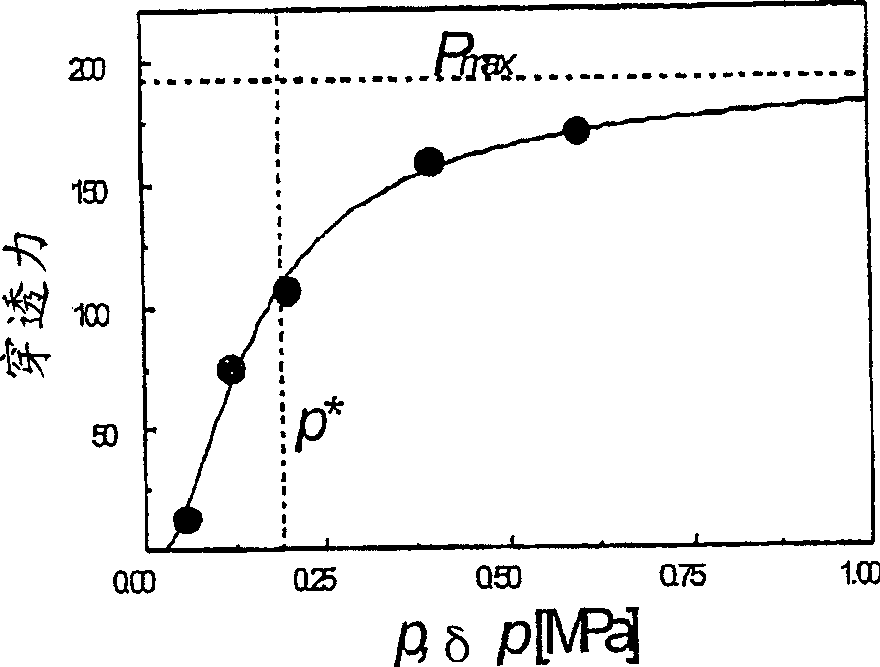Aggregate with increased deformability, comprising at least three amphipats, for improved transport through semi-permeable barriers and for the non-invasive drug application in vivo, especially throug
A technology of amphiphilic substances and aggregates, applied in the field of surface aggregates, can solve the problems of low penetration rate and lipid vesicles that are not beneficial
- Summary
- Abstract
- Description
- Claims
- Application Information
AI Technical Summary
Problems solved by technology
Method used
Image
Examples
Embodiment 1-120
[0291] Components:
[0292] 37.74-84.5mg soybean phosphatidylcholine (SPC, -85% purity, MFC)
[0293] Imported as ethanol solution
[0294] SPC / EtOH=1 / 1 V / V and includes about 10%
[0295] Charged phospholipids (presumably anionic phosphatidylglycerol)
[0296] 187-34.9mg Polysorbate (Tween 80, medicinal etc.)
[0297] Level; MDC 1 )
[0298] 5.6-20rel.mol-% sodium dodecyl sulfate (SDS, p.a.; MDC2)
[0299] Replace phospholipids to a given amount
[0300] ad 1ml isotonic phosphate buffer solution (pH=7.2)
[0301] aims : In order to test the synergy between membrane destabilization and thereby increase the adaptability of aggregates, the activity of two different surfactants combined with phospholipids was used as a component of the basic membrane formation system.
[0302] Suspension formulation In order to prepare a series of phospholipid / surfa...
Embodiment 121-129
[0307] Components:
[0308] 14.2mg polysorbate (Tween 80)
[0309] 85.8mg soy phosphatidylcholine (SPC) is the same as in Example 1-120
[0310] 0-17.5rel.mol-% sodium dodecyl sulfate (SDS), equivalent to SPC and
[0311] Replace the phospholipid to the amount given
[0312] ad 1ml isotonic phosphate buffer solution (pH=7.2)
[0313] aims : As in Examples 1-120, test the synergistic effect of different surfactants on the properties of the unfolded surface aggregates.
[0314] Suspension preparation : The method used to prepare the vesicle suspension is the same as that of Examples 1-120. The only significant difference between the test series is slightly larger than the average diameter and polydispersity of the vesicles used in Examples 121-129.
[0315] Transport ability of aggregate suspension (pore penetration ability and adaptability) In order to define the resistance characteristics of the semipermeable barrier with the suspension flow rate (=trans...
Embodiment 130-131
[0319] Component :
[0320] 52.1mg soybean phosphatidylcholine (SPC), the actual amount = 52.2mg-Na
[0321] Cholesterol mg amount
[0322] 45.2mg polysorbate (Tween 80)
[0323] 5,10,15mol-% sodium cholate=Na cholesterol (relative to suspension SPC)
[0324] ad 1ml isotonic phosphate buffer solution (pH=7.2)
[0325] aims : Same as Example 1-120, but using a different charged surfactant (with cholate instead of SDS)
[0326] Suspension preparation The initial suspension was prepared as in the previous example. However, in order to prepare more uniform vesicles in the test formulation before the actual measurement, the initial suspension was pre-filtered through a filter with 80 nm pores. By dynamic light scattering using ALV 5000correlator and a personal computer, the diameter of the bilayer vesicle was determined to be about 120nm.
[0327] Vesicle transport activity (pore penetration capacity / adaptability) The actual transport test is done with...
PUM
| Property | Measurement | Unit |
|---|---|---|
| radius | aaaaa | aaaaa |
| radius | aaaaa | aaaaa |
| radius | aaaaa | aaaaa |
Abstract
Description
Claims
Application Information
 Login to View More
Login to View More - R&D
- Intellectual Property
- Life Sciences
- Materials
- Tech Scout
- Unparalleled Data Quality
- Higher Quality Content
- 60% Fewer Hallucinations
Browse by: Latest US Patents, China's latest patents, Technical Efficacy Thesaurus, Application Domain, Technology Topic, Popular Technical Reports.
© 2025 PatSnap. All rights reserved.Legal|Privacy policy|Modern Slavery Act Transparency Statement|Sitemap|About US| Contact US: help@patsnap.com



